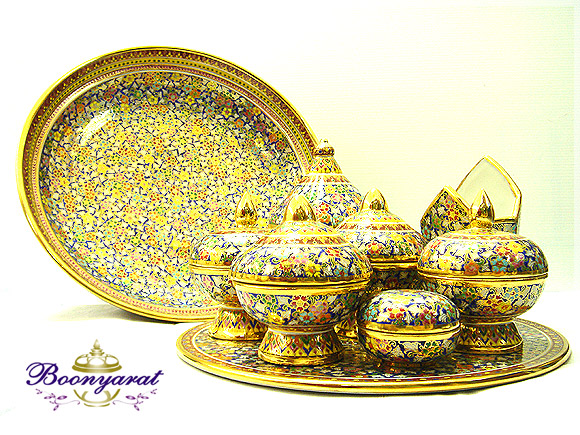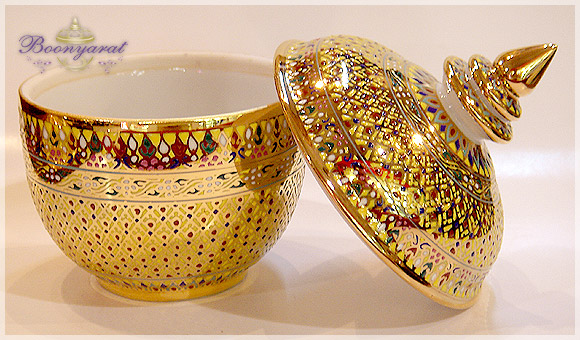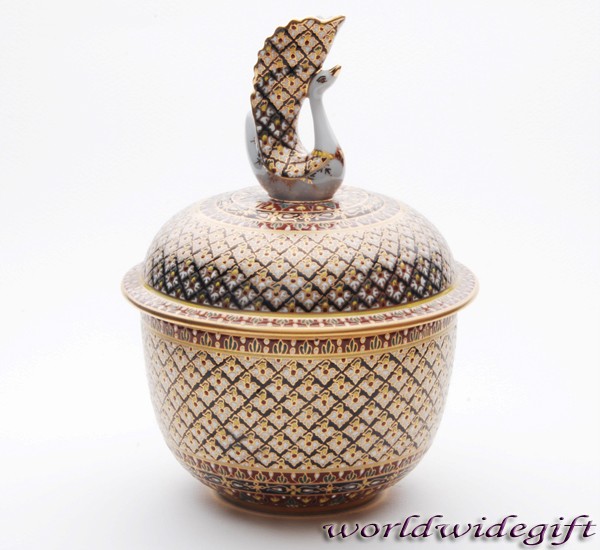Thai BENJARONG
 "BENJARONG" IS THE NAME GIVEN TO BONE CHINA AND PORCELAIN WHICH IS HANDPAINTED IN THAILAND. THE RANGE OF PRODUCTS AVAILABLE IN BENJARONG EXTENDS TO TABLEWARE (DINNER SERVICES, TEA AND COFFEE SERVICES) IN BONE CHINA AND LAMP BASES, VASES, COVERED POTS, CANDLESTICKS AND SMALL BOXES MOSTLY IN PORCELAIN.
"BENJARONG" IS THE NAME GIVEN TO BONE CHINA AND PORCELAIN WHICH IS HANDPAINTED IN THAILAND. THE RANGE OF PRODUCTS AVAILABLE IN BENJARONG EXTENDS TO TABLEWARE (DINNER SERVICES, TEA AND COFFEE SERVICES) IN BONE CHINA AND LAMP BASES, VASES, COVERED POTS, CANDLESTICKS AND SMALL BOXES MOSTLY IN PORCELAIN.
 "BENJARONG" IS THE NAME GIVEN TO BONE CHINA AND PORCELAIN WHICH IS HANDPAINTED IN THAILAND. THE RANGE OF PRODUCTS AVAILABLE IN BENJARONG EXTENDS TO TABLEWARE (DINNER SERVICES, TEA AND COFFEE SERVICES) IN BONE CHINA AND LAMP BASES, VASES, COVERED POTS, CANDLESTICKS AND SMALL BOXES MOSTLY IN PORCELAIN.
"BENJARONG" IS THE NAME GIVEN TO BONE CHINA AND PORCELAIN WHICH IS HANDPAINTED IN THAILAND. THE RANGE OF PRODUCTS AVAILABLE IN BENJARONG EXTENDS TO TABLEWARE (DINNER SERVICES, TEA AND COFFEE SERVICES) IN BONE CHINA AND LAMP BASES, VASES, COVERED POTS, CANDLESTICKS AND SMALL BOXES MOSTLY IN PORCELAIN.
The origins of Benjarong are traced back to the Ming Dynasty in China (1368 - 1644). Tradition has it that, some six hundred years ago, a princess from China married into the Siam (now Thailand) Royal Family and brought with her Benjarong porcelain. At that time it is understood that Benjarong porcelain was being made only for the Emperor of China. Benjarong was then supplied from China to the King of Siam for several generations. Eventually deposits of kaolin were discovered in Siam which allowed the production of porcelain to commence in that country.The King of Siam brought over from China some of the artists and established workshops in his country.
Benjarong continued to be produced in small communities of artists, with skills handed down from generation to generation, for the next four hundred years. During this period Benjarong was produced exclusively for use in the palaces of the Siam Royal Family. Some of the patterns shown on the Benjarong marketed by us are of Chinese origins and go back to the Ming Dynasty. These ancient patterns are free-form (unstructured), such as the Vine Flowers ("Dok-mai-Khod") and Butterfly and contrast with the more structured and geometric patterns devised within Siam. Many of the Siam patterns were designed in the reign of King Rama II (1809 - 1824), but further patterns evolved over the next hundred years. In particular, the trellis pattern dates to the reign of one of their greatest kings, King Rama V (or King Chulalongkorn 1868 - 1910).
It was during the reign of King Rama V that craftsmen were sent from Siam to England to learn the technique of making bone china and this product has since been made there.
Eary in the 1900's King Rama V permitted Benjarong to be used by his aristocracy and by certain wealthy and influential merchants. The present King of Thailand, King Rama IX (otherwise known as King Bhumibol) decreed at the commencement of his reign, some sixty years ago, that Benjarong henceforth was to be available to all who had the means to purchase it.
The term "Benjarong" is derived from the Balinese word "benja" and the Sanskrit word "rong" which together literally mean "five colours". Traditionally the five colours were red, yellow, green, blue and white. In more recent times these colours have been augmented by maroon and high purity (18 carat) gold. Designs over the centuries have increased in number, but many still include as their basic elements: the rose, the lotus flower, and emblems representing the Chakri and Supan dynasties in Thailand. Generally, Benjarong is characterised by densely painted and delicately detailed designs with enamelled relief glaze emphasising the background which is further accentuated by gold.



ไม่มีความคิดเห็น:
แสดงความคิดเห็น